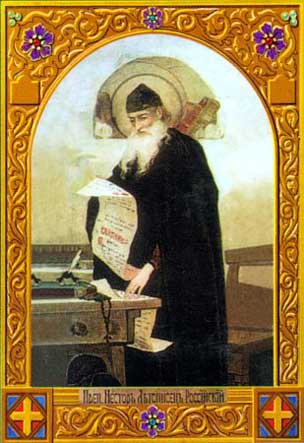
The Monk Nestor the Chronicler
Commemorated on October 27
The
Monk Nestor the Chronicler was born at Kiev in 1050. He came in his youth
to the Monk Theodosii (Feodosii, + 1074, Comm. 3 May) and became a novice. The
Monk Nestor took monastic vows under the successor to the Monk Theodosii, the
hegumen Stephen, and under him was ordained monk-deacon.
Concerning
his lofty spiritual life it says that, amidst the number of other monastic
fathers he participated in the casting out of a devil from Nikita the Hermit
(afterwards a Novgorod Sainted-hierarch, Comm. 31 January), having become
fascinated by the Hebrew wisdom of the Old Testament. The Monk Nestor deeply
appreciated true knowledge, conjoined with humility and penitence. "Great
is the benefit of book learning, – said he, – for books point out and teach
us the way to repentance, since from the words of books we discover wisdom and
temperance. This is the stream, watering the universe, from which springs
wisdom. In books is a boundless depth, by them we are comforted in sorrows, and
they are a bridle for moderation. If thou do enter diligently into the books of
wisdom, thou then shalt discover great benefit for thy soul. Wherefore that one
who readeth books, doth converse with God or the saints".

In
the monastery the Monk Nestor had the obedience of being the chronicler. In the
1080's he wrote the "Account about the Life and Perishing of the Blessed
PassionBearers Boris and Gleb" in connection with the transfer of the
relics of the saints to Vyshgorod in the year 1072 (Comm. 2 May). In the 1080's
the Monk Nestor also compiled the Life of the Monk Theodosii of Pechersk. And
in 1091 on the eve of the altar-feast of the Pechersk monastery, he was
entrusted by the hegumen John to dig up out of the ground, for transfer to the
church, the holy relics of the Monk Theodosii (Uncovering Relics, Comm. 14
August).
The
chief work in the life of the monk Nestor was the compiling in the years 1112‑1113
of the "Tale of Bygone Years" ("Povest' Vremmenykh Let").
"Here is the tale of years gone by, from whence the Russian land came to
be, who at Kiev started first to be prince and from whither the Russian land is
arrayed" – so with the very first line the Monk Nestor specifies his
purpose. His is an extraordinarily wide circle of sources: of prior Russian
chronicle accounts and sayings, monastery records, the Byzantine Chronicles of
John Malalos and George Amartolos, various historical collections, the accounts
of the boyar-elder Ian Vyshatich and of tradesmen and soldiers, of journeymen
and of those who knew – all set together by him with an unified and strict
Church point of view. This permitted the Monk Nestor to write his history of
Russia as an inclusive part of world history – the history of the salvation of
the human race.
The
monk-patriot expounds the history of the Russian Church in the significant
moments of its historical settings. He speaks about the first mentioning of the
Russian nation in historical sources – in the year 866, during the time of the
holy Patriarch of Constantinople Photios; he narrates about the creation of the
Slavonic alphabet and writing by the holy Equal-to-the-Apostles Cyril and
Methodius; and about the Baptism of holy Equal-to-the-Apostles Ol'ga at
Constantinople. The chronicle of the Monk Nestor has preserved for us an
account about the first Orthodox church in Kiev (under the year 945), about the
confessors deed of the holy Varangian Martyrs (under the year 983), about the
"testing of the faiths" by the holy Equal-to-the-Apostles Vladimir
(year 986) and the "Baptism of Rus'" (the year 988). We are indebted
to the first Russian Church historian for accounts about the first
metropolitans of the Russian Church, about the emergence of the Pechersk
monastery, and about its founders and ascetics. The times in which the Monk
Nestor lived were not easy for the Russian land and the Russian Church. Rus'
lay torn asunder by princely feuds; the steppe Polovetsian nomads laid waste
both city and village with plundering raids, they snatched off Russian people
into slavery, and burnt churches and monasteries. The Monk Nestor was an
eyewitness to the devastation of the Pechersk monastery in the year 1096. In
the chronicle is given a theologically thought out patriotic history. The
spiritual depth, historical fidelity and patriotism of the "Tale of Bygone
Years" [in English otherwise also known as "The Russian Primary
Chronicle"] establish it among the ranks of significant creations of world
literature.
The
Monk Nestor died in about the year 1114, having left to the Pechersk
monk-chroniclers the continuation of his great work. His successors in the
writing of the chronicles were: the hegumen Syl'vestr, adding on contemporary
accounts to the "Tale of Bygone Years"; the hegumen Moisei (Moses)
Vydubitsky lengthened it to the year 1200; and finally, the hegumen Lavrentii,
having written in the year 1377 the most ancient of our surviving copies that
preserve the "Tale" of the Monk Nestor (this copy is known as the
"Lavrentian Chronicle"). The hagiographic tradition of the Pechersk
ascetics was continued by Sainted Simon, Bishop of Vladimir (+ 1226, Comm. 10
May), the compiler of the "Kievo-Pechersk Paterikon". Narrating the
events connected with the lives of the holy saints of God, Saint Simon often
quotes, from among other sources, the Chronicles of the Monk Nestor.
The
Monk Nestor was buried in the Nearer Caves of the Monk Antonii of Pechersk. The
Church also honours his memory together with the Sobor (Assemblage) of the holy
Fathers of the Nearer Caves on 28 September and on the 2nd Sunday of Great Lent
when is celebrated the Sobor of all the Kievo-Pechersk Fathers. His works have
many times been published [in English also as "The Russian Primary
Chronicle"].
© 1996-2001 by translator Fr. S. Janos.